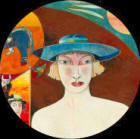NOTA CRITICA
... // nostro destino è fatto dalle
esperienze che viviamo nel corso della vita.
A volte viene voglia di fermarsi e di
guardarsi indietro, per fissare nella mente
gli eventi più importanti, sia individuali che
collettivi.
E un po' quello che succede con la
pittura di Rincicotti, che racconta le proprie
esperienze attraverso la propria arte, sapendo
affrontare anche tematiche di
carattere filosofico.
Con la serie dedicata allo zodiaco ecco
come i nostri destini astrali prendano
una forma e un aspetto, inseriti in contesti surreali
dove il colore, materico e
prezioso, suggerisce modalità di visione inedite.
Lasciarsi ammaliare da un quadro di
Rincicotti è cosa semplice, vista l'immediatezza
con cui i colori e le forme seducono la retina.
Leggere un quadro di Rincicotti è invece
un'operazione complessa, perché l'autore
definisce la trama del suo racconto in maniera allusiva,
lasciando a ciascuno il desiderio
o la possibilità di entrare in un mondo nuovo, fatto di
simboli, di archetipi, di ricordi,
di sogni, di spiritualità, da percorrere un po' alla
volta, entrando per gradi in una realtà parallela che
potremmo definire metafisica. Costruire un racconto in
pittura significa dar luogo a immagini e forme dal forte
potere evocativo, capaci di esprimere non solo un
sentimento o un'emozione, ma anche di stimolare a
livello mentale un percorso narrativo.
Rincicotti si esprime attraverso immagini
che sembrano ritagliate da un sogno,


personaggi che esprimono la loro estraneità al mondo
reale rivelandosi quali archetipi
del grottesco, attraverso le note mesto tragiche di una
gigantomachia che irride la realtà
mostrandone il suo lato oscuro, ma riuscendo comunque a
evocare sempre un sentimento
di ingenua freschezza. Con i suoi riferimenti alle
avanguardie del novecento, ma anche
con la capacità di citare la lezione del rinascimento
italiano, la pittura di Rincicotti sa
essere colta, raffinata, contraddistinta da quel senso
della misura che è di matrice squisitamente classica,
una misura che non consente mai all'occhio di stancarsi,
così
come i fantasmi delle paure ataviche che si affacciano
dalle sue tele non cedono mai
spazio ad una vuota retorica.
C'è la capacità di esprimere tutto con
equilibrio, di irridere il presente e tutte le sue
finzioni, ma anche di dare delle risposte, costruendo la
favola di un mondo nuovo che
dietro alla maschera - come disse a proposito Maurizio
Calvesi - svela il volto apollineo
della speranza.
Lucia Majer
Our destiny is made of the experiences we
live in the course of our life.
Sometimes we would stop and look back to
fix in our mind the most important events,
our personal ones and the collective ones.
It’s what happens with Rincicotti’s
paintings, he reveals the own experiences though his
own art but he is also able to deal with philosophical
subjets.
The series “Zodiac” shows how our astral
destinies take a shape and an appearance in
a surreal context where the precious and materic color
suggests unheard of vision.
It’s easy to be captured by Rincicotti’s
picture thanks to the immediacy of colors and
shapes that seduce the retina, but reading one of his
works is a very complex thing,
since the author fixes the plate of his tale in an
allusive way. Rincicotti leaves everyone
the desire or the possibility to enter a new world, made
of symbols, archetypes,
memories, dreams, spirituality to run trough step by
step, entering by degrees a parallel reality that we
could call ”a methafisical one”.
“Building” a tale in painting means
leading to images and shapes with a strong evocative
power, which can express not only a sentiment or an
emotion but also whet a narrative
path on a mental level.
Rincicotti expresses himself though
images that seem to be cut out from dreams, if you
could give to dreams the concrete form of paper: you
will meet character non bonging to
real world, archetypes of the grotesque, through the sad
notes of a gigantomachy that
laugh at the reality revealing it dark side but evoking
an ingenuous freshness.
Thanks to the references to the vanguards
of the XX century and the ability to quote the
lesson of the Italian Renaissances, Rincicotti’s
painting is learned, refined, marked by
the classical sense of the moderation that doesn’t allow
you eye to get bored; at the
same way the phantoms and the atavic fears that appear
in his paintings never lead to
a pure rethoric.
The painter is able to express his world
in a balanced way, he can laugh at the present
and its pretences, giving at the same time some answers
and building the fable of a new
world that reveals the Apollonian appearance of hope
behind a mask (as Maurizio Calvesi
said about).
Lucia Majer
Luigi Rincicotti was born in Fano Italy
on 13th august 1941. he run more than 250
personal exhibitions in Italy an abroad and got more
than 50 national and international prices (sept. 2004 he
won the Faber Price given by Senate in Rome).
Together with Mr. Barbieri and Prof:
Grosso he recently established the Operative
Museum “New”.
Fifty permanent works are in Giacobini Palace in
Altomonte (Cosenza).
Trad. Claudia Neri

